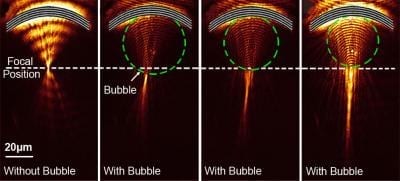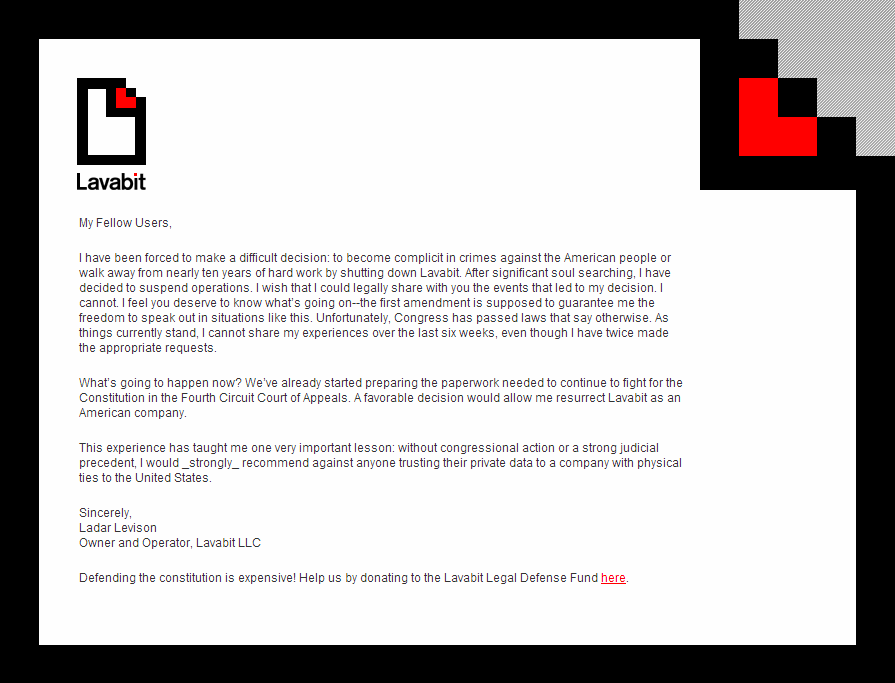
The materials to form bubble lenses are inexpensive, and the bubbles themselves are easy to dissolve, replace and move.
Bending light beams to your whim sounds like a job for a wizard or an a complex array of bulky mirrors, lenses and prisms, but a few tiny liquid bubbles may be all that is necessary to open the doors for next-generation, high-speed circuits and displays, according to Penn State researchers.
To combine the speed of optical communication with the portability of electronic circuitry, researchers use nanoplasmonics — devices that use short electromagnetic waves to modulate light on the nanometer scale, where conventional optics do not work. However, aiming and focusing this modulated light beam at desired targets is difficult.
“There are different solid-state devices to control (light beams), to switch them or modulate them, but the tenability and reconfigurability are very limited,” said Tony Jun Huang, associate professor of engineering science and mechanics. “Using a bubble has a lot of advantages.”
The main advantage of a bubble lens is just how quickly and easily researchers can reconfigure the bubble’s location, size, and shape — all of which affect the direction and focus of any light beam passing through it.
Huang’s team created separate simulations of the light beams and bubble lens to predict their behaviors and optimize conditions before combining the two in the laboratory. They published their findings in Nature Communications.
To form the bubble lens, researchers used a low-intensity laser to heat water on a gold surface. The tiny bubble’s optical behavior remains consistent as long as the laser’s power and the environmental temperature stay constant.
Simply moving the laser or adjusting the laser’s power can change how the bubble will deflect a light beam, either as a concentrated beam at a specific target or as a dispersed wave. Changing the liquid also affects how a light beam will refract.
The materials to form bubble lenses are inexpensive, and the bubbles themselves are easy to dissolve, replace and move.
“In addition to its unprecedented reconfigurability and tenability, our bubble lens has at least one more advantage over its solid-state counterparts: its natural smoothness,” said Huang. “The smoother the lens is, the better quality of the light that pass through it.”
The Latest Bing News on:
Nanoscale light beams
- Researchers 'unzip' 2D materials with laserson May 8, 2024 at 7:44 am
Researchers used commercially available tabletop lasers to create tiny, atomically sharp nanostructures in samples of a layered 2D material called hexagonal Boron Nitride (hBN). The new nanopatterning ...
- Plasmonic Crystals: Harnessing Light at the Nanoscaleon April 20, 2024 at 12:50 pm
and nanoscale light manipulation. The periodic nature of plasmonic crystals enables the design of advanced optical functionalities, such as light trapping, waveguiding, and beam steering, which are ...
- Nanoscale movies shed light on one barrier to a clean energy futureon April 12, 2024 at 5:05 am
New research is shedding light on one barrier to a clean energy future: corrosion. Using nanoscale imaging techniques ... which shoots a beam of electrons through nanocrystals suspended inside ...
- Nanoscale movies shed light on one barrier to a clean energy futureon April 10, 2024 at 5:00 pm
To take pictures of such tiny objects, they used a transmission electron microscope, which shoots a beam of electrons through ... catalyst breaking down with nanoscale resolution,” Moreno ...
- Nanoscale movies shed light on one barrier to a clean energy futureon April 10, 2024 at 5:00 pm
Using nanoscale imaging techniques ... they used a transmission electron microscope, which shoots a beam of electrons through nanocrystals suspended inside a super-thin pocket of liquid to ...
- Nanoscale Movies Shed Light on One Barrier to a Clean Energy Futureon April 9, 2024 at 5:00 pm
Using nanoscale imaging techniques ... To take pictures of such tiny objects, they used a transmission electron microscope, which shoots a beam of electrons through nanocrystals suspended inside a ...
- Propagating dimensions of light: Deforming versatile non-diffractive beams along the optical trajectoryon April 8, 2024 at 8:11 am
This spreading of light beams during propagation limits the efficient ... using the precise arrangement of nanoscale antenna arrays to miniaturize optical devices and achieve multidimensional ...
- A simple, scalable method using light to 3D print helical nanostructureson March 18, 2024 at 1:54 pm
The new study demonstrates a way to make them by 3D-printing "forests" of nanoscale helices. Aligning the helices' axes with a light beam creates strong optical rotation, enabling chirality to be ...
- Nanophotonics – harnessing light at the nanoscaleon November 13, 2023 at 12:56 pm
The nanoscale geometry of metamaterials provides powerful degrees ... and information processing with light Left beam: Light propagation inside a photonic crystal is forbidden by a propagation gap.
- Free electrons get light out of a holeon May 16, 2019 at 4:26 am
4). More recently, researchers have proposed using carbon nanotubes as nanoscale periodic structures and producing tunable light by sending an electron beam through the tube 5. The periodic ...
The Latest Google Headlines on:
Nanoscale light beams
[google_news title=”” keyword=”Nanoscale light beams” num_posts=”10″ blurb_length=”0″ show_thumb=”left”]
The Latest Bing News on:
Bubble lenses
- Best Places to Buy Replacement Prescription Lenses Online in 2024on May 6, 2024 at 1:18 pm
Need to replace your lenses but love your frames? Here are the best online places to shop at for replacement lenses. Executive Editor David Carnoy has been a leading member of CNET's Reviews team ...
- Play Bubble Mouse Blast Online for Free | Yahoo! Gameson May 4, 2024 at 1:07 pm
Bubble Mouse Blast is the ultimate bubble-popping thrill. Blast bubbles by matching 3 of the same color. Be quick: You only have 3 seconds to shoot once the bubble is in the cannon. Bounce bubbles ...
- Best Places to Buy Contact Lenses Online for 2024on May 2, 2024 at 9:26 am
Getting contacts is now easier than ever, skip the doctor's office with the best places to buy contact lenses online. Nasha is a Managing Editor for CNET, overseeing our sleep and wellness verticals.
- pehael 2+2 Pack iPhone 14 Plus Privacy Screen Protector with Camera Lens Protector Full Coverage Anti-Spy Tempered Glass Film 9H Hardness Bubble Free, Now 21% Offon April 30, 2024 at 9:37 am
Are you among those seeking full coverage, top-notch quality, and next-level privacy precautions for your mobile device? Allow us to present the answer to your needs: the Pehael iPhone 14 Plus Privacy ...
- Best lenses for astrophotography in 2024on April 27, 2024 at 11:14 am
If you're looking to get serious about night-sky photography, one of the best lenses for astrophotography could be a great addition to your kit. These specialist lenses are designed with large ...
- The Best Micro Four Thirds Lenses for 2024on April 17, 2024 at 5:00 pm
Wide-angle lenses capture an epic, broad view of the world and are ideal for landscapes and architectural imaging. For Micro Four Thirds, look for lenses that cover angles wider than 12mm.
- The best iPhone lenses in 2024on April 17, 2024 at 7:07 am
The best iPhone lenses can improve the photographic skills of even the latest and greatest Apple smartphones. Whichever iOS device you own, the best iPhone lenses can improve your photography ...
- From boom to burst, the AI bubble is only heading in one directionon April 13, 2024 at 8:31 am
No one should be surprised that artificial intelligence is following a well-worn and entirely predictable financial arc “Are we really in an AI bubble,” asked a reader of last month’s column ...
- Horizon Forbidden West: All Signal Lenseson April 7, 2024 at 5:00 pm
Signal Lenses are vital collectibles intertwined with lore and quests, found atop high cliffs in Horizon Forbidden West. Raynah awaits your collection progress, starting near Lens of Evening ...
- The Stock Market Is Not In A Bubble, No Foolin'on April 1, 2024 at 11:15 am
Folks flapping their gums and clacking their keyboards about an "everything bubble" are just looking for attention, because, you know, any publicity is good publicity. The data does not support an ...
The Latest Google Headlines on:
Bubble lenses
[google_news title=”” keyword=”bubble lenses” num_posts=”10″ blurb_length=”0″ show_thumb=”left”]









